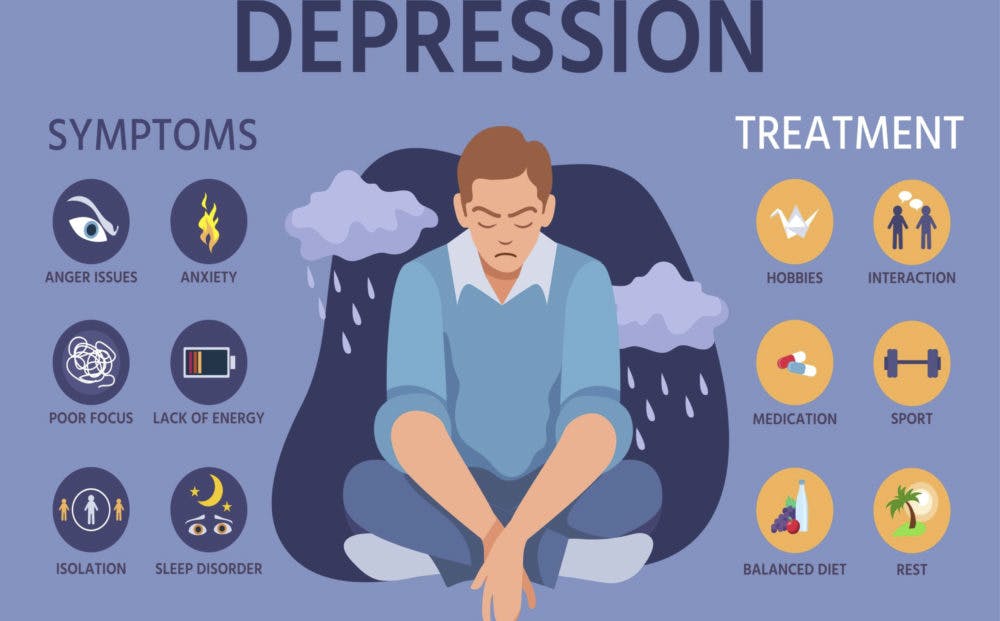Depression is a short-term state or a long-term clinical disorder. Feeling sad, discouraged, or unhappy is a symptom of short-term depression. These feelings generally resolve over the course of a few days or less.
Long-term depression is a psychiatric disorder. Certain diagnostic criteria must be met. The diagnosis of the major depressive disorder requires psychiatric evaluation by a qualified professional. The diagnosis includes several of the following:
- weight loss
- sleep disturbances
- agitation
- fatigue or loss of energy
- feelings of worthlessness or guilt
- diminished concentration
- and possibly recurrent thoughts of death.
It is estimated that 1 in 5 adults will suffer from a major depressive disorder. The incidence is higher in women. One in 4 adolescents suffers from depression and this increases the risk of depression later in life.

Depression and Your Physical Health
Depression has also been linked to obesity, diabetes, and heart disease. All of these disorders, including depression, are on the rise in the U.S. They are also commonplace in outpatient physical therapy clinics where individuals are recovering from injuries.
We believe the knowledge and positive habits learned in physical therapy help people with symptoms of depression and chronic disease. Follow-through with a long-term exercise program leads to meaningful changes in mood, physical health, and quality of life. All of these benefits are achieved without the adverse effects associated with other forms of treatment.
Conventional Treatments for Depression
Antidepressant medication is the staple treatment for depression. About 1/2 of individuals with depression will respond favorably to prescription medications. The other half will either not respond to treatment or suffer side effects. Common side effects include constipation, sleep loss, blurred vision, weight gain, fatigue, nausea, and sexual dysfunction.
Treatment may involve individual or group counseling lasting several months. Psychotherapy is an effective long-term treatment for depression. This form of treatment is often used in conjunction with antidepressant medication for individuals with more severe depression. Cognitive-behavioral therapy is one form of psychotherapy that aims to identify and change negative thoughts in those with depression.
Exercise as a Treatment for Depression
As a stand-alone treatment, exercise has been shown to result in moderate to large improvements in depressive symptoms. Research has also shown no difference in outcomes when comparing exercise to cognitive behavioral therapy. When combining the results from four studies, no differences were found between the effects of exercise and antidepressant medication.
This is not to suggest that medication and psychotherapy are ineffective. Instead, exercise may enhance the effects of these conventional treatments for depression. And perhaps, exercise may even be able to replace them over time.
Type and Dose of Exercise to Manage Depression
Most studies showing positive effects with exercise have included some form of aerobic exercise. Walking, jogging, and cycling are the most common forms of aerobic exercise. The optimal frequency of exercise is different for everyone. But most studies have included exercising 3-5 times per week.
Programs with higher energy expenditures produce greater results. But lower-intensity programs also lead to improvements in mental health. A good starting point is to perform short walks 3 days per week.

As aerobic capacity and confidence improve, progress based on the American College of Sports Medicine recommendations. This includes moderate-intensity exercise performed for at least 30 minutes 5 days per week. As aerobic capacity improves, progress your exercise intensity and duration so you continue to make gains.
Tips to Increase Chances of Success
The 1st challenge with any exercise program is simply taking the first step. Starting small and gradually building up the intensity, duration, and frequency is a wise approach. Expect minor setbacks along the way and do not become discouraged when they occur.
The antidepressant effects of exercise take time. Be patient. Once you begin to notice small progress in your exercise capacity and overall well-being, momentum will start to build. The key to long-term adherence is to stay disciplined and develop habits for a lifetime. Below are a few tips to help you on your journey.
- Pick a form of exercise you enjoy and stick with it
- Invest in a good pair of sneakers to exercise in
- Pick a time of day to exercise that works best for you and make this part of your daily routine
- Set your own goals and track your progress
- Anticipate barriers (fatigue, work duties, bad weather, etc) and develop solutions ahead of time
- Team up with a partner or partners and you will be more likely to stick with it
- Missing 1 session is no reason to become discouraged. If you fall off, get right back on the next day.
- Take a minute and appreciate how you feel at the end of each exercise session
The physical therapists at BSR have been helping people in Southern Ocean County move without pain since 2007. Start by scheduling an appointment with one of our doctors of physical therapy.

